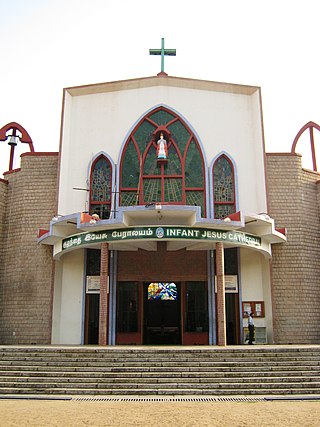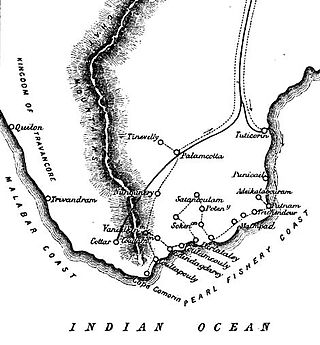
Roberto de Nobili was an Italian priest, a member of the Society of Jesus (Jesuits), who worked as a missionary in Southern India. He used novel methods to preach Christianity, adopting many local customs of India which were, in his view, not contrary to Christian principles, and he won papal approval for a policy of accommodation that allowed coverts to Christianity to continue to engage in Hindu practices deemed social practices rather than expressions of Hinduism.
Paravar is a Tamil maritime community, mainly living in the state of Tamil Nadu, Kerala, and in Sri Lanka. Historically, they were inhabitants of the Neithal (coastal) lands of Tamil Nadu, and find mention in various ancient Tamil literary works.
Malabar rites is a conventional term for certain customs or practices of the natives of South India, especially Madurai, Mysore and the Carnatic, which the Jesuit missionaries in the early seventeenth century allowed their Indian neophytes to retain after conversion.

The Thanjavur Nayakdynasty were the rulers of Thanjavur in the 15th and 17th centuries. The Nayaks, who belonged to the Telugu-speaking Balija social group were originally appointed as provincial governors by the Vijayanagara Emperor in the 15th century, who divided the territory into Nayak kingdoms which were Madurai, Tanjore, Gingee and Kalahasthi. In the mid-15th century they became an independent kingdom, although they continued their alliance with the Vijayanagara Empire. The Thanjavur Nayaks were notable for their patronage of literature and the arts.

John de Britto, SJ, also known as Arul Anandar, was a Portuguese Jesuit missionary and martyr, often called "the Portuguese St Francis Xavier" by Indian Catholics.
The caste system among South Asian Christians often reflects stratification by sect, location, and the caste of their predecessors. There exists evidence to show that Christian individuals have mobility within their respective castes. But, in some cases, social inertia caused by their old traditions and biases against other castes remain, causing caste system to persist among South Asian Christians, to some extent. Christian priests, nuns, Dalits and similar groups are found in India, Pakistan, Bangladesh, and Nepal.
The Madurai Nayaks were a Telugu dynasty who ruled most of modern-day Tamil Nadu, India, with Madurai as their capital. The Madurai Nayaks had their origins in the Balija warrior clans of present-day Andhra Pradesh. The Nayak reign which lasted for over two centuries from around 1529 to 1736 was noted for its achievements in arts, cultural and administrative reforms, revitalization of temples previously ransacked by the Delhi Sultans, and the inauguration of a unique architectural style.
Missionary work of the Catholic Church has often been undertaken outside the geographically defined parishes and dioceses by religious orders who have people and material resources to spare, and some of which specialized in missions. Eventually, parishes and dioceses would be organized worldwide, often after an intermediate phase as an apostolic prefecture or apostolic vicariate. Catholic mission has predominantly been carried out by the Latin Church in practice.
Roman Catholic Brahmin is a Christianised caste among the Goan, Bombay East Indian & Mangalorean Catholics; who are patrilineal descendants of Konkani Brahmin and Daivajna converts to the Latin Church. This occurred parts of the Konkan region that were annexed into the Portuguese East Indies, with the capital (metropole) at Velha Goa & Bombay was the largest territory (province) of Portuguese India. They retain some of the ethno-social values and customs of their ancestors, and most of them exhibit a noticeable hybrid Latino-Concanic culture. They were known as the Brahmins among the "New Christians". Two Portuguese Prime Ministers Antonio Costa and Alfredo Nobre da Costa were of mixed Catholic Brahmin descent.

The Diocese of Salem is a Latin Church ecclesiastical jurisdiction or diocese of the Catholic Church in India. Its episcopal see is Salem. The Diocese of Salem is a suffragan in the ecclesiastical province of the metropolitan Archdiocese of Pondicherry and Cuddalore.
Henrique Henriques (1520–1600) was a Portuguese Jesuit priest and missionary who spent most of his life in missionary activities in South India. After his initial years in Goa he moved to Tamil Nadu where he mastered Tamil and wrote several books including a dictionary. He is considered to be the first European Tamil scholar.

The introduction and early development of printing in South India is attributed to missionary propaganda and the endeavours of the British East India Company. Among the pioneers in this arena, maximum attention is claimed by the Jesuit missionaries, followed by the Protestant Fathers and Hindu Pandits. Once the immigrants realized the importance of the local language, they began to disseminate their religious teachings through that medium, in effect ushering in the vernacular print culture in India. The first Tamil booklet was printed in 1554 in Lisbon - Cartilha em lingoa Tamul e Portugues in Romanized Tamil script by Vincente de Nazareth, Jorge Carvalho and Thoma da Cruz, all from the Paravar community of Tuticorin.
Punnaikkayal, is a harbour city in Tamil Nadu, India.

The Pearl Fishery Coast refers to a coastal area of southern India, extending along the Coromandel Coast from Tuticorin to Comorin ruled by Paravars and their rulers.

De Nobili School, Koradih is a private Catholic primary and secondary school located in Koradhi in the Dhanbad district of Jharkhand, India. Founded in Sijua in 1975 by the Jesuits, the school is a branch of the De Nobili Schools Group.

De Nobili School, Sindri is a private Catholic primary and secondary school located in Sindri in the Dhanbad district of the state of Jharkhand, India. Founded in 1963 by the Jesuits as a boarding and day school, the school prepares students for the Indian Certificate of Secondary Education (ICSE) examination in class 10 and for the Indian School Certificate (ISC) in class 12.

De Nobili School, Mugma is a private Catholic primary and secondary school located in Mugma, a settlement in the Dhanbad district of the state of Jharkhand, India. Founded by the Jesuits in 1977, the English-medium school teaches students from grade one to grade twelve and prepares students for the Indian Certificate of Secondary Education (ICSE) examination in class 10 and for the Indian School Certificate (ISC) in class 12.

De Nobili School, CTPS, Bokaro also known as De Nobili School, Chandrapura is a private Catholic secondary school located in Chandrapura, Bokaro in the state of Jharkhand, India. Founded and run by the Jesuits, the English medium school includes Nursery to Class 10.

De Nobili School, Maithon is a private Catholic primary and secondary school located in Maithon, in the Dhanbad district of the state of Jharkhand, India. The English-medium school is run by the Society of Jesus.
Ines G. Županov is a Croatian historian and Indologist. She is a director of the Centre d’études de l’Inde et de l’Asie du Sud and senior research fellow at the CNRS, Paris.














